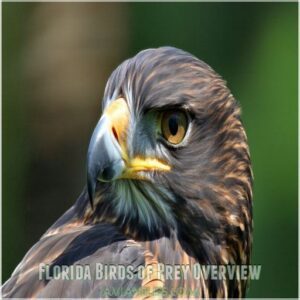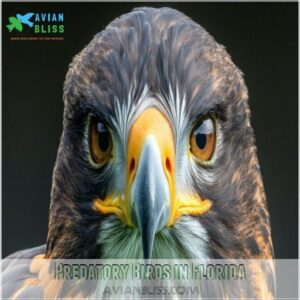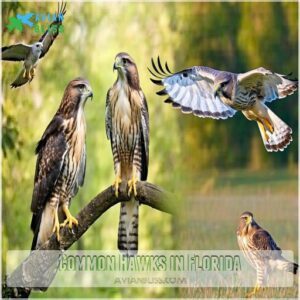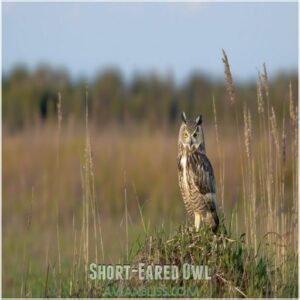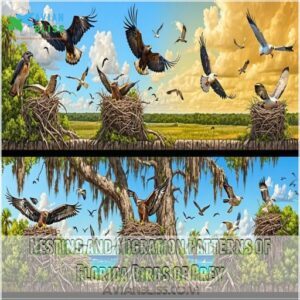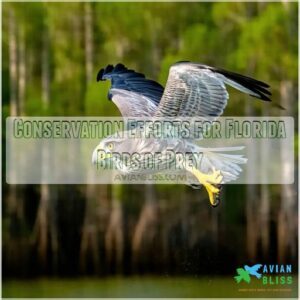This site is supported by our readers. We may earn a commission, at no cost to you, if you purchase through links.
 Florida birds of prey include over 50 fascinating raptor species, from the iconic bald eagle to the sharp-eyed red-tailed hawk.
Florida birds of prey include over 50 fascinating raptor species, from the iconic bald eagle to the sharp-eyed red-tailed hawk.
These masterful hunters help keep ecosystems in balance by controlling rodents, scavenging carrion, and adding to the wild charm of the state.
You’ll find red-shouldered hawks perched in woodlands, northern harriers gliding across grasslands, and turkey vultures cleaning up nature’s messes like unsung heroes.
Florida’s owls, like the short-eared owl, bring silent nocturnal drama, while peregrine falcons stun with record-setting dives.
Each species has its own flair, making them a marvel to observe. Curious about Florida’s raptors? There’s plenty more to uncover!
Table Of Contents
- Key Takeaways
- Florida Birds of Prey Overview
- Raptors and Birds of Prey in Florida
- Predatory Birds in Florida
- Common Hawks in Florida
- Notable Florida Eagles
- Vultures and Their Role in Florida Ecosystems
- The Owls of Florida
- Falcons and Kites in Florida
- Nesting and Migration Patterns of Florida Birds of Prey
- Conservation Efforts for Florida Birds of Prey
- Frequently Asked Questions (FAQs)
- What are the most interesting Florida Birds of prey?
- What do birds in Florida eat?
- Are there predatory birds in Florida?
- Do birds of prey live in Florida?
- How many birds of prey are in Florida?
- Are there birds in Florida?
- What is the large predatory bird in Florida?
- What is the rarest bird in Florida?
- What is the most common hawk in Florida?
- What are the aggressive birds of prey?
- Conclusion
Key Takeaways
- You’ll find over 50 raptor species in Florida, from the iconic bald eagle to agile falcons and stealthy owls, thriving in diverse habitats like wetlands, woodlands, and urban areas.
- Birds of prey play a crucial role in balancing ecosystems by controlling pests, scavenging carrion, and maintaining food chains.
- Conservation efforts, such as preserving habitats and reducing human threats, are essential to ensuring the survival of Florida’s birds of prey.
- Observing these predators, whether it’s an osprey diving for fish or a red-tailed hawk soaring above, offers a stunning glimpse into nature’s precision and adaptability.
Florida Birds of Prey Overview
Step into the domain of Florida’s birds of prey, where majestic hunters rule the skies from wetlands to urban landscapes. Boasting over 50 species, these incredible raptors are nature’s ultimate survivors – from the iconic bald eagle to the stealthy Cooper’s hawk.
These feathered predators play a pivotal role in ecosystem balance, controlling rodent populations and cleaning up carrion with surgical precision.
Bird identification tips become your passport to understanding these extraordinary creatures.
While some species face conservation challenges, Florida’s dedicated efforts protect these winged warriors.
Whether you’re a casual observer or a serious birder, you’ll be mesmerized by their hunting techniques – from osprey’s dramatic plunges to vultures’ efficient scavenging. Just remember: respect their space and marvel from a distance.
Raptors and Birds of Prey in Florida
Ready to explore the wild world of Florida’s sky hunters? Raptors aren’t just birds—they’re nature’s precision predators that’ll blow your mind! These feathered fighters dominate Florida’s diverse landscapes, from coastal waters to dense forests, sporting razor-sharp talons and eagle-eye vision that make them ultimate survival machines.
Imagine ospreys plunging into crystal-blue waters, snatching fish with surgical accuracy. Picture red-shouldered hawks perched silently in suburban woodlands, scanning for unsuspecting prey. Each raptor species tells a unique story of adaptation and ecological mastery.
Florida’s raptor populations aren’t just awesome—they’re critical ecosystem managers. These birds control rodent populations, maintain delicate food chains, and serve as indicators of environmental health. Whether it’s the majestic bald eagle soaring over marshlands or a nimble American kestrel hovering above grasslands, these birds represent nature’s perfect design.
Conservation matters more than ever. Protecting their habitats guarantees these incredible hunters continue their age-old dance of survival in Florida’s rich, interconnected wilderness.
Predatory Birds in Florida
Often, Florida’s predatory birds paint an awe-inspiring picture of survival and adaptation. You’ll marvel at their incredible hunting techniques and diverse behaviors across the Sunshine State’s varied landscapes.
From red-shouldered hawks ambushing prey in dense forests to white-tailed kites hovering gracefully over grasslands, these birds showcase nature’s remarkable precision.
Understanding bird behavior reveals complex survival strategies amid growing conservation challenges. Habitat loss threatens many species, making human awareness essential.
Legal protection has helped some populations recover, like the once-struggling bald eagle. Each bird of prey tells a unique story of resilience, whether it’s a snail kite extracting apple snails or a falcon diving with breathtaking speed.
Your support matters – by learning about these magnificent raptors, you’re helping protect Florida’s ecological balance.
Common Hawks in Florida
A diverse array of hawks grace Florida’s ecosystems, each species painting a unique picture of survival and adaptation. You’ll encounter these winged hunters in various landscapes, from urban edges to wild marshlands.
Their hunting strategies reveal nature’s intricate design:
- Red-shouldered hawks perch strategically along woodland borders
- Cooper’s hawks weave through urban spaces with lightning precision
- Sharp-shinned hawks pursue prey with remarkable agility
Hawk identification becomes a thrilling challenge for wildlife enthusiasts. The red-tailed hawk, with its distinctive rusty-red tail, soars prominently across Florida’s skies. Northern harriers glide effortlessly over grasslands, their hunting techniques honed by generations of survival.
Conservation efforts have been essential in preserving Hawk Habitats and Distribution, demonstrating remarkable resilience in changing environments. Each hawk species tells a story of ecological balance, showcasing the delicate yet powerful dance of predator and prey in Florida’s rich, complex landscape.
Notable Florida Eagles
In the vast wilderness of Florida, two majestic eagle species command the skies: the legendary Bald Eagle and the elusive Golden Eagle. Your journey into the lives of these incredible raptors begins with their awe-inspiring presence across the Sunshine State’s diverse landscapes.
Bald Eagles, with their distinctive white-feathered heads and powerful silhouettes, dominate coastal areas and lakeshores, building massive nests that can weigh up to a ton and span an impressive 7.5 feet, often with materials sourced from Florida eagle nests. These winged titans showcase remarkable adaptability, thriving in ecosystems ranging from saltwater marshes to dense woodlands.
While Bald Eagles have made an incredible comeback through conservation efforts, Golden Eagles remain rare visitors, their dark brown plumage and golden nape turning heads of the lucky few who spot them.
Prime eagle-watching destinations like the Everglades and Merritt Island Wildlife Refuge offer front-row seats to these magnificent birds. Weighing up to 14 pounds and boasting wingspans that rival small aircraft, these eagles embody the untamed spirit of Florida’s wild spaces.
Vultures and Their Role in Florida Ecosystems
You mightn’t realize it, but vultures are nature’s cleanup crew in Florida’s diverse ecosystems.
They’re not just creepy scavengers – these incredible birds play a vital role in maintaining environmental health by efficiently removing dead animals and preventing disease spread.
The Connection Between Vultures and Cleanliness
Nature’s sanitation squad soars high above Florida’s landscapes, with vultures playing a critical role in ecosystem maintenance. These unsung heroes clean up what others avoid, preventing potential disease outbreaks through their remarkable scavenging abilities. Effective Florida vulture cleanup requires a combination of natural and human efforts, including supplies and equipment from specialized stores vulture cleanup products.
- Their acidic stomachs demolish harmful pathogens
- They reduce decomposition-related health risks
- They minimize roadkill and associated environmental hazards
Black and turkey vultures aren’t just flying garbage disposals – they’re sophisticated biological cleanup systems. By consuming carrion, they stop the spread of dangerous bacteria and limit disease-carrying insect populations. These raptors carefully process organic waste, transforming potential health threats into ecological balance. Their hygienic habits mightn’t win beauty contests, but they’re essential for maintaining Florida’s delicate environmental web, where sometimes the most important jobs aren’t the most glamorous.
Vulture Conservation in Florida
Magical cleanup crews face serious threats in Florida’s ecosystem.
Vulture conservation tackles habitat loss, declining populations, and human conflicts head-on.
Researchers track these incredible birds through strategic monitoring programs, protecting their critical role in waste management.
With targeted education initiatives, conservationists are changing public perception about these misunderstood raptors. Funding remains essential for preserving vulture populations, ensuring these natural recyclers continue maintaining Florida’s delicate environmental balance. Every saved vulture means one more guardian of our wild spaces. Vulture conservation is crucial. Florida’s ecosystem depends on it.
The Owls of Florida
You’ll be fascinated by Florida’s owls, nature’s silent hunters that prowl the night with razor-sharp precision and incredible adaptability.
From the heart-shaped face of the Barn Owl to the distinctive hoots of the Great Horned Owl,
these feathered predators will capture your imagination with their unique hunting strategies and incredible survival skills.
Short-Eared Owl
In Florida’s open grasslands and marshes, you might spot the short-eared owl—a winter visitor with a flair for hunting.
These ground-nesting, nocturnal predators rely on sharp hearing to snag voles and small birds.
Unlike the towering great horned or barred owls, they prefer sweeping low flights. Watching their fluttery, almost dance-like hunting moves is like seeing a choreographed show.
Mastering Florida bird identification? Short-eared owls are definitely worth the spotlight!
Northern Saw-Whet Owl
The Northern Saw-whet Owl is a pint-sized predator you might spot in Florida’s dense forests during its winter migration.
These nocturnal raptors hunt small rodents with precision while staying hidden. Their soft toot-toot-toot calls can sometimes give them away.
Saw-whet owl habitat is shrinking due to deforestation, making conservation necessary to protect these birds.
Unlike the Barred Owl or Great Horned Owl, these elusive Florida birds of prey rely heavily on protected woodlands to thrive.
Falcons and Kites in Florida
Florida’s falcons and kites offer a high-flying glimpse into nature’s brilliance. The Peregrine Falcon, nicknamed “speed demon,” rules the skies with record-breaking dives topping 240 mph. Contrasting its drama, the Swallow-tailed Kite gracefully glides through Florida summers, mesmerizing with its forked tail before migrating to South America. Don’t overlook the Mississippi Kite, an agile acrobat that swoops through woodlands and parks while feasting on insects mid-air. The petite American Kestrel—North America’s smallest falcon—combines charm and precision, hovering to snag unsuspecting prey.
These birds thrive in varied Florida Birds of Prey habitats, from coastal zones to wetlands, reflecting their adaptability.
- Falcon hunting techniques highlight aerial acrobatics and sharp precision.
- Kite migration routes display impressive distance and navigation.
- Conservation efforts safeguard their preservation as urban growth encroaches.
- Falcons vs. kites diets differ, balancing ecosystems naturally.
Nesting and Migration Patterns of Florida Birds of Prey
You’ll be amazed at how Florida’s birds of prey travel incredible distances and build nests in surprising locations.
Understanding their nesting and migration patterns helps you appreciate their role in keeping ecosystems healthy.
The Importance of Nesting and Migration
When you watch Florida birds of prey, have you ever thought about how critical nesting and migration are for their survival?
Habitat loss threatens their traditional nesting sites, while shifting migration routes impact access to food.
Climate change throws off timing, disrupting fragile ecosystems. Breeding success often hinges on perfectly timed prey abundance.
Birds like raptors adapt with impressive strategies, but these challenges demand action. Birds of prey face many challenges.
- Picture this: a red-shouldered hawk soaring thousands of miles, only to find its nesting site replaced by a parking lot.
Examples of Nesting and Migratory Florida Bird Species
Birds of prey in Florida have fascinating nesting habitats and migration routes.
Swallow-tailed Kites breed in towering trees, then soar south to South America. Bald Eagles are loyal homebodies, often reusing nests yearly. Ospreys cleverly build near water for easy meals.
Many raptors like hawks in Florida are attracted to specific habitats, such as wetlands and forests.
These seasonal shifts, seen in raptor migration and bird migration alike, face pressures from habitat loss.
Protecting nests guarantees thriving breeding seasons for Florida raptor identification and conservation efforts.
Conservation Efforts for Florida Birds of Prey
Florida’s birds of prey aren’t just awe-inspiring—they’re essential pieces in the puzzle of wildlife conservation.
Efforts to protect these raptors show just how connected humans are to their survival. Take the Snail Kite, for example; better water management has helped this rare hunter bounce back from habitat loss.
Meanwhile, organizations like the Conservancy of Southwest Florida are stepping up to rescue injured birds, from Black Skimmers to mighty Great Horned Owls.
For those looking to support raptor conservation efforts, volunteering with local Florida bird rescue initiatives can be a rewarding experience.
Human interaction plays a double-edged role—while eco-awareness helps save species, careless actions like pesticide use or disturbing nests can threaten them. Climate change adds to the challenge, reshaping migration patterns and food sources.
Imagine looking up to see their silhouettes slicing through the sky. That’s the reward of bird conservation—not just numbers on a spreadsheet but witnessing these majestic birds thrive where they belong: high above Florida’s wild spaces. Florida’s birds of prey. Wildlife conservation. Raptor conservation. Human interaction. Climate change.
Frequently Asked Questions (FAQs)
What are the most interesting Florida Birds of prey?
Ever feel like nature’s superheroes are watching you?
Golden Eagles soar with power, Peregrine Falcons dive faster than sports cars, and owls like the Great Horned bring mystery.
Florida’s birds of prey turn every glance skyward thrilling!
What do birds in Florida eat?
Birds in Florida feast on a smorgasbord—fish, snakes, small mammals, insects, and even carrion.
Some, like owls, hunt under moonlight, while hawks dive from the skies.
It’s nature’s all-you-can-eat buffet, raptor-style.
Are there predatory birds in Florida?
In Florida’s skies, predators rule the roost.
Eagles, hawks, and owls dominate with sharp talons and keen eyes.
Snagging prey like fish, rodents, and smaller birds.
Watch them soar, but stay cautious!
Do birds of prey live in Florida?
Florida’s home to a remarkable variety of birds of prey, from agile falcons to majestic eagles and stealthy owls.
These predators thrive in diverse habitats,
so keep your eyes peeled for soaring wings and sharp talons!
How many birds of prey are in Florida?
Did you know there are 26 birds of prey found in Florida?
From agile hawks to powerful eagles and stealthy owls, these raptors command the skies,
blending sharp hunting skills with incredible adaptability across habitats.
Are there birds in Florida?
You’ll find an amazing diversity of birds in Florida.
From colorful herons and egrets to powerful birds of prey like hawks and eagles.
With its unique habitats, Florida is truly a birdwatcher’s paradise!
What is the large predatory bird in Florida?
The Bald Eagle reigns as Florida’s large predatory bird.
This majestic raptor, with its white head, massive wingspan, and sharp talons, thrives near water, hunting fish and surprising you with its stunning power.
What is the rarest bird in Florida?
Determining the rarest bird in Florida is tricky, as populations fluctuate.
The Florida Grasshopper Sparrow, found only in central Florida’s dry prairies, is considered one of the rarest and most endangered birds in the state.
What is the most common hawk in Florida?
You’ll often spot the Red-shouldered Hawk soaring through Florida’s forests and suburban areas.
Known for its reddish chest and sharp "kee-ah" call,
this adaptable hawk hunts squirrels with a dramatic dive from above.
What are the aggressive birds of prey?
Imagine a feathered boxer sizing you up.
Aggressive birds of prey like hawks, owls, and eagles defend nests fiercely, dive-bomb intruders, and even target small pets.
Keep your distance, and they’ll respect yours.
Conclusion
What’s next? Florida birds of prey are waiting to amaze you, whether it’s the piercing dive of a peregrine falcon or the quiet grace of an owl under the moon.
These incredible raptors both balance ecosystems and add wild beauty to Florida’s skies and forests.
From hawks to eagles, each species tells a unique story.
Grab your binoculars, head outside, and start exploring—you’ll never look at the skies the same way again!

